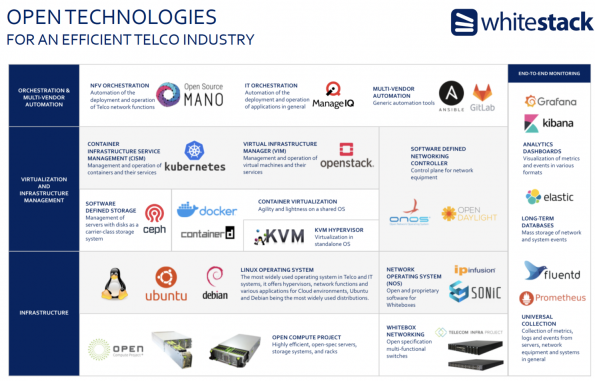Throughout the last decade, many open technologies have emerged to contribute to specific areas of the Telco business. These technologies, sometimes hidden behind SDN, NFV, and network disaggregation concepts, not only include open-source software projects for cloud infrastructure, networking operating systems, controllers, orchestrators, and automation tools, but also open hardware specifications that implement networking and compute systems at scale.
Today, the matureness of many of these technologies has reached a level that is turning them into de facto standards that effectively cover all the Telco Cloud and networking needs in an end-to-end fashion. Strong examples are the Linux, OpenStack, and Kubernetes combination in the software world (what the OpenInfra foundation is positioning as LOKI: The OpenInfra Standard), as well as merchant silicon switches (white boxes) and the Open Compute Project‘s servers in the hardware world.
But, as more open projects arise and mature, popular questions from operators keep being the same:
- How can a Telco effectively leverage all these technologies?
- Who will support them?
- Which one is the right combination of tools?
- How should they be used and integrated correctly?

Over the last few years, at Whitestack, we have realized that the most efficient approach for an operator is to adopt these technologies through partners that are able to build commercial, supported distributions of the related projects, implement them efficiently, and provide external support for them, but most importantly, in a way that the operator does not lose ownership and control of their infrastructure. In this way, the operator is not only increasing its know-how but can eventually be familiar with the technologies enough to change, over time and if needed, the solution’s provider, without replacing the underlying technology. This implies some responsibilities from the operator’s side, which include:
- Studying and taking ownership of the technical requirements in a way that aligns with the latest open technologies (without asking for more, or less, than what the industry can provide)
- Choosing providers that keep a transparent alignment with the open projects and that have a healthy relationship with the communities.
- Taking responsibility for the architecture design, with the providers’ expertise as an extra input when needed.
That answers the first two questions, but which one is the current “right” combination of tools that can support the end-to-end Telco business? The answer can change over time, but for reference, in the following picture you will see a layered diagram of the main mature technologies that Whitestack uses for its products at this point:

Finally, how should they be integrated correctly? Assuming that an operator wants to mix different providers for different parts of its network, the key consideration is to select providers that keep a transparent implementation of the open technology. That single decision will ensure that the APIs used for interoperability offer the maximum compatibility that the industry can offer at any given point in time so that mixing providers does not become a nightmare.
Overall, through the right use of open technologies, as described above, operators are not only recovering important levels of efficiency, but also, by moving away from more “vendor management” towards more “engineering”, they are regaining control of their cloud and networking infrastructure, and that is a BIG change that impacts people’s motivation and know-how, and as a consequence, the overall business survivability.
- Reimagining a Telco Using Open Technologies - February 16, 2022
- Takeaways from the first open multi-vendor NFV showcase - May 22, 2019
- 5G projects building strong use cases for Open Source MANO NFV - February 25, 2019

)







